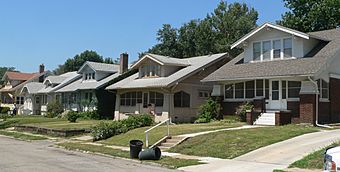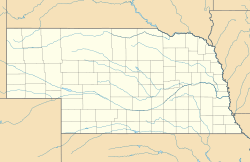Minne Lusa facts for kids
Quick facts for kids |
|
|
Minne Lusa Residential Historic District
|
|

Houses on Bauman Avenue
|
|
| Location | Omaha, Nebraska |
|---|---|
| Architect | Everett Dodd |
| Architectural style | Late 19th And 20th Century Revivals, Late 19th And Early 20th Century American Movements |
| NRHP reference No. | 14000178 |
| Added to NRHP | April 25, 2014 |
The Minne Lusa Residential Historic District is a special neighborhood in North Omaha, Nebraska. It is listed on the National Register of Historic Places. This means its buildings and history are important to the whole country.
The neighborhood is a great example of a large area with many affordable family homes. These homes were built between 1915 and 1941 by one company. You can see many different house styles here, like bungalows and Craftsman homes. These styles were very popular when the neighborhood was built.
There are 540 buildings in Minne Lusa that help make it a historic district. Another 167 buildings are also in the area but do not count towards its historic status. Minne Lusa Boulevard, a main street, is also an important part of the district.
The Minne Lusa district is bordered by Vane Street to the north and Redick Avenue to the south. North 24th Street is on the east, and North 30th Street is on the west. It is just north of the Miller Park neighborhood. It is also just south of Florence. The district includes all the land once known as the Minne Lusa Addition.
A Look Back in Time
The name "Minne Lusa" comes from a Native American word. Its exact meaning is not known, but it is thought to mean "clear water." The Minne Lusa Pumping Station was built nearby in 1899. The neighborhood, started 17 years later, likely got its name from this station.
Charles Martin first planned the Minne Lusa neighborhood in 1916. By 1923, all the homes were built. Minne Lusa was located southeast of Florence, which had just become part of Omaha. It was called the "largest addition ever planned in Omaha."
The neighborhood had 800 building lots on 33 blocks. The prices for these lots ranged from $450 to $1,000. Minne Lusa Boulevard cut through the middle of the area. It curved north from Miller Park.
Most of the homes were built in the Craftsman bungalow style or other popular styles of the time. Larger homes were usually built along Minne Lusa Boulevard. Smaller homes were built on the streets that crossed it.
Everett S. Dodds, a well-known architect from Omaha, helped design many parts of the development.
Minne Lusa grew when cars were becoming more affordable for many families. Because of this, almost every original home in the neighborhood was built with a garage. If not, a garage was added very soon after.
Interesting Buildings in the Area
Some buildings are in the Minne Lusa district but are not considered "contributing" to its historic status. This is because they have been changed a lot over the years.
The original Minne Lusa School first opened as Fort School in 1916. It was moved and rebuilt, opening in its current spot in 1924. The school was updated in 1955 and again in 1997.
Another local landmark is called the Viking Ship. It is a building with a unique design at Minne Lusa Boulevard and Redick Avenue. Over time, it has been known as the Prettiest Mile Club, Hayden House, and the Birchwood Club. People say it is the oldest building in the neighborhood.
The Hayden House eventually moved from the Viking Ship building to Eppley Airfield. Then it moved to the Union Station in downtown Omaha. Today, it is a fully restored art deco building. You can see it at the Durham Western Heritage Museum.
The area also used to have the Minne Lusa Theater. This was a single-screen movie theater that opened in the mid-1930s on North 30th Street. It could seat 400 people. The theater closed sometime in the mid-1950s.
Minne Lusa Water Works
The Metropolitan Utilities District runs a large system at the Florence Water Works. This system cleans water from the Missouri River. The Minne Lusa Pumping Station was a very large building made of Warrensburg sandstone. It had a tall central tower and an arched entrance.
Omaha architects designed this building, which was built in 1889. Its style showed the influence of the 1898 Trans-Mississippi Exposition. This building held the pumps and boilers that sent clean water to all of Omaha through city water pipes. The city tore down this pumping station in the 1960s.



